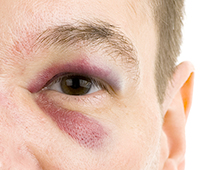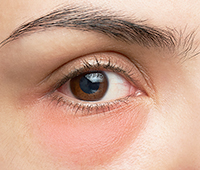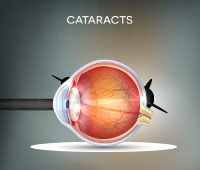WHAT IS Astigmatism
- Definition
- Causes
- Symptoms
- Diagnosis
- Ayurvedic Tips
- FAQS
- References
Definition

Burning of eyes is symptom that can be seen in many different conditions based on the causes. The causes can range from simple to complex, and often burning of eyes occurs along with other symptoms such as itching, eye pain, watery eyes or discharge.1
Ayurveda describes netra daha (burning of eyes) as a symptom due to vitiation of the Pitta dosha. The symptom may occur alone in pittaja vitiation alone, or may be accompanied with irritation (if vataja factors are involved) or congestion in eye (if kaphaja factors are involved).2
Disclaimer: The information on this page is not intended to be a substitute for professional medical advice. Do not use this information to diagnose or ayurvedic treatment of ophthalmology-eye-diseases and/or astigmatism without consulting the doctor. Consult your physician before beginning an exercise regime. "While we have products /ayurvedic medicines for ophthalmology-eye-diseases and/or astigmatism, you must consult an authorized physician before taking any of the products. For more information on products, visit www.dabur.com or call 1800-103-1644"
Causes
Causes OF Astigmatism
The most common cause of a burning sensation in the eye is inflammation or swelling. This may happen due to an infection or an external foreign particle causing irritation as in blepharitis (inflammation of eyelids), pink eye, allergies and Dry Eye Syndrome. Long term wearing of contact lenses and extended exposure to computers - computer vision syndrome is also known to cause burning in the eyes.1
Allergies to certain environmental pollutants, pollens, or air also are common cause of developing a burning sensation in the eye.1
Disclaimer: The information on this page is not intended to be a substitute for professional medical advice. Do not use this information to diagnose or ayurvedic treatment of ophthalmology-eye-diseases and/or astigmatism without consulting the doctor. Consult your physician before beginning an exercise regime. "While we have products /ayurvedic medicines for ophthalmology-eye-diseases and/or astigmatism, you must consult an authorized physician before taking any of the products. For more information on products, visit www.dabur.com or call 1800-103-1644"
Symptoms
Symptoms OF Astigmatism
The signs and symptoms of burning in eyes can be seen in either one or both eyes simultaneously. Following signs and symptoms are observed1 -
- Eyes have a stinging or burning sensation
- Redness of the eye
- Irritation or sensation of having something in the eyes
Disclaimer: The information on this page is not intended to be a substitute for professional medical advice. Do not use this information to diagnose or ayurvedic treatment of ophthalmology-eye-diseases and/or astigmatism without consulting the doctor. Consult your physician before beginning an exercise regime. "While we have products /ayurvedic medicines for ophthalmology-eye-diseases and/or astigmatism, you must consult an authorized physician before taking any of the products. For more information on products, visit www.dabur.com or call 1800-103-1644"
Diagnosis
Diagnosis OF Astigmatism
A complete medial history and a detailed eye examination are required to diagnose the exact cause for burning sensation.1 Your doctor may recommend one or more of the following tests:
- Slit lamp exam: It creates 3D view of different parts of the eye and is used to detect eye problems at an early stage.3
- Examining the eyelids.4
- Examining the eye motion.4
- Visual field test: Your complete visual field is the entire area seen by both eyes when your gaze is fixed in one direction. This test checks for gaps in your side vision, which may be leading to burning eyes. 5
Additional tests for checking allergies and infections may be required too.1
Disclaimer: The information on this page is not intended to be a substitute for professional medical advice. Do not use this information to diagnose or ayurvedic treatment of ophthalmology-eye-diseases and/or astigmatism without consulting the doctor. Consult your physician before beginning an exercise regime. "While we have products /ayurvedic medicines for ophthalmology-eye-diseases and/or astigmatism, you must consult an authorized physician before taking any of the products. For more information on products, visit www.dabur.com or call 1800-103-1644"
Ayurvedic Tips
Ayurvedic Tips Astigmatism
A complete medial history and a detailed eye examination are required to diagnose the exact cause for burning sensation.1 Your doctor may recommend one or more of the following tests:
- Slit lamp exam: It creates 3D view of different parts of the eye and is used to detect eye problems at an early stage.3
- Examining the eyelids.4
- Examining the eye motion.4
- Visual field test: Your complete visual field is the entire area seen by both eyes when your gaze is fixed in one direction. This test checks for gaps in your side vision, which may be leading to burning eyes. 5
Additional tests for checking allergies and infections may be required too.1
Diet Recommendations (Aahar)
- Recommended foods that should be included in the diet every day such as ghee, milk, rock salt, honey, patola (snake gourd), red rice, green gram, wheat, triphala churna (3 fruits), carrots and leafy vegetables6
- Cold infusions prepared with coriander seeds may be help reduce burning sensation
- Avoid foods such as sour foods, dry meat, all alcohols, fishes, curd, tobacco, excessive hot and fatty foods 6
Lifestyle changes (Vihar)
- Walk regularly
- Wear headgear such as caps and hats, and protective eyegear such as sunglasses to protect from UV radiations
- Properly clean the eye everyday
- Avoid long exposure to computers by taking frequent breaks.
- Make sure you get good sleep regularly
- Make it a habit to wake up early
- Applying ghee on feet followed by some massage may be beneficial.
- Practice some exercises for your eyes. Suggestions are given below.
Exercises for the eye:
- Blinking exercise: Blink your eyes every 3-4 seconds over 2 minutes. Repeat this exercise several times a day.
- Palming: Rub the palms of your hands and place them gently over your eye lids.
- Eye rotation: Rotate your eye balls in all directions for a few minutes. Repeat this exercise several times a day.
Disclaimer: The information on this page is not intended to be a substitute for professional medical advice. Do not use this information to diagnose or ayurvedic treatment of ophthalmology-eye-diseases and/or astigmatism without consulting the doctor. Consult your physician before beginning an exercise regime. "While we have products /ayurvedic medicines for ophthalmology-eye-diseases and/or astigmatism, you must consult an authorized physician before taking any of the products. For more information on products, visit www.dabur.com or call 1800-103-1644"
FAQS
FAQS
1. How does Glaucoma develop?
The primary cause of developing Glaucoma is having an increased pressure inside the eye. This leads to damage of the optic nerve – that affects the vision. The increase of pressure is due to the accumulation of the fluid of the eye called as Aqueous humor. This accumulation is either because the fluid is not being drained or it is being overproduces. The reasons for these to happen are not fully understood but probable causes are genetic.1
2. I am diagnosed with dry AMD. Are there any recommendations of herbs/foods that are beneficial in this case?
As per Ayurveda, herbs like Triphala [3 fruits of haritaki (chebulic myrobalan), bibhitaki (Beleric myrobalan) and amalki (gooseberry), Tulsi (Basil), Spirulina, Punarnava (Hogweed/Boerrhavia diffusa), Shatavari (Asparagus) having anti-oxidant and vitamin properties. These along with carotene containing foods (such as carrots) are beneficial in dry AMD.
3. What is Myopia? How does one get it?
Myopia is refractive error. It means that due to the elongation of the eyeball, the rays of light coming from distant object do not come directly on the retina but falls in front of it. This is because the cornea or lens is not curved smoothly, causing improper refraction of light rays.
It is very common and generally develops slowly. It is found across age groups – from children to adults. It also tends to run in families.
4. What is astigmatism, how is it caused?
Astigmatism is refractive error. Due to unknown causes, if the curvature of cornea or lens is disturbed, the rays of light coming from an object would not come directly on the retina but falls either in front or beyond it. This leads to a blurring of vision and in Astigmatism this blurring can happen either horizontally, vertically or diagonally.
5. What are the causes of a red eye?
Conjunctivitis or red eye is caused due to a swelling of the conjunctiva (The membrane covering the eyeball). This is often due to an infection of the membrane. The causes of the infection are either a virus or bacteria. Sometimes, conjunctivitis may also occur due to a reaction or splash of chemical irritant inside the eye.
6. What is cataract? How does one know if he/she has cataract?
Cataract refers to the cloudy appearance of the lens of the eye which causes a clouded vision. Due to the clouding of the vision, a person suffering from cataract finds it very difficult to see properly, read anything or even drive a car.
There may be no signs and symptoms at an early stage but as the condition progresses, the following signs and symptoms are observed1 -
- Clouding of vision, blurring of images
- High sensitivity to direct light or glare
- Difficulty seeing at night or in dim light
- Observing ‘halo’ effect around lights
- Rapid changes in the focal numbers of eyeglasses/contact lens
- Double vision
7. What should I do for dry eyes?
For those suffering from dry eyes, avoidance of factors such as long hours on TV/Computer along with adequate body hydration are recommended. Regular blinking and few eye exercises as mentioned should be followed.
- Blinking exercise: Blinking of eyes for a particular period at frequent intervals
- Palming: Rubbing the palms of hands and placing them gently over the eye lids.
- Eye rotation: Rotation of the eye ball in all directions at frequent intervals.
8. I have double vision. What could be the cause and how can it be evaluated?
A complete medical history and a detailed eye examination are required to diagnose the exact cause for diplopia. Additional tests may be required to find any underlying nervous or mechanical cause, which are -
- Retinoscopy – to test for the appearance of the lens, retina and images
- Slit lamp examination - to test for certain structures inside the eye
- A Magnetic Resonance Imaging (MRI) or Computed Tomography (CT) scan may be needed, to detect abnormalities of the eye socket (orbit), skull and brain.
9. How does one develop allergy in the eye?
An allergic reaction starts when a person’s immune system mistakes an otherwise harmless substance for a dangerous attacker. The cells in the eye produce antibodies to an allergen on first contact. When a similar contact with the substance happens again, the same antibodies signal the immune system to release chemicals - called histamine - into the bloodstream, causing a reaction that leads to the signs and symptoms.
Common allergy triggers for the eye, include many allergens existing in air, or certain types of foods and different venoms through insect stings - such as bee stings or wasp stings or certain medications.
10. What kind of infection can commonly occur in the eye?
Eye infections are known to cause swelling and irritations in the eye, and are caused either by a bacteria, fungus or virus. The common eye infections seen are Conjunctivitis or red eye and Stye. Conjunctivitis causes a swelling of the conjunctiva (the membrane covering the eyeball) and stye is an infection in the eyelids. This is often due to an infection of the membrane. While this condition does not affect the vision, it causes a lot of irritation in the eye and discomfort.
Disclaimer: The information on this page is not intended to be a substitute for professional medical advice. Do not use this information to diagnose or ayurvedic treatment of ophthalmology-eye-diseases and/or astigmatism without consulting the doctor. Consult your physician before beginning an exercise regime. "While we have products /ayurvedic medicines for ophthalmology-eye-diseases and/or astigmatism, you must consult an authorized physician before taking any of the products. For more information on products, visit www.dabur.com or call 1800-103-1644"
References
References
- Hellem A et al. Burning Eyes: Causes and How to Get Relief. Available at http://www.allaboutvision.com/conditions/burning-eyes.htm accessed Sept 8th 2016
- A clinical study to assess the efficacy of Usheer Heem in Netradaha w.s.r. Computer Vision Syndrome. Asian Journal of Multidisciplinary Studies, 3(5) May, 2015
- Kanaujia S et al. Concept of Allergic Conjunctivitis on Ayurvedic Prospectus. J Biol Scien Opin. 2016; 4(3): 101-103
- Slit Lamp Examination. Wed MD. Available at http://www.webmd.com/eye-health/slit-lamp-examination, accessed Sept 13th 2016
- Goldberg C. Eye Exam. UC San Diego. Available at https://meded.ucsd.edu/clinicalmed/pe_eyeexam.pdf, accessed Sept 13th 2016
- Vision Tests. Wed MD. Available at http://www.webmd.com/eye-health/vision-tests, accessed Sept 13th 2016
- Prakash SC et al. Ayurvedic Opthalmology an Approach through Holistic Diet and Regimen. IJMPNP. 2015; Vol. 1(2): 31-34
- THE SIGNIFICANCE OF KRIYAKALPA IN NETRA ROGA. Unique Journal of Ayurvedic and Herbal Medicines, 03 (03), May-June 2015 14
Disclaimer: The information on this page is not intended to be a substitute for professional medical advice. Do not use this information to diagnose or ayurvedic treatment of ophthalmology-eye-diseases and/or astigmatism without consulting the doctor. Consult your physician before beginning an exercise regime. "While we have products /ayurvedic medicines for ophthalmology-eye-diseases and/or astigmatism, you must consult an authorized physician before taking any of the products. For more information on products, visit www.dabur.com or call 1800-103-1644"
Know more on Ophthalmology/ Eye diseases



